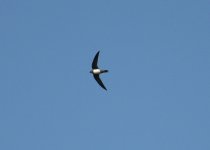kim
Well-known member
Went to the Wirral in Cheshire this afternoon to try and see the Alpine Swift - and was lucky. However it was very high in the sky and it moved!!!
I managed to get a few shots in but they were all about the same standard. I have cropped it but that is all. I used Apperture Priority 5.6 and ISO was 200 - unfortunately I thought I had put it at 400. Howevber the bloke next to me was on 100ISO. I would appreciate any advice as to the best tactics in these sort of situations - or should one just enjoy the bird and forget about the photo?
I managed to get a few shots in but they were all about the same standard. I have cropped it but that is all. I used Apperture Priority 5.6 and ISO was 200 - unfortunately I thought I had put it at 400. Howevber the bloke next to me was on 100ISO. I would appreciate any advice as to the best tactics in these sort of situations - or should one just enjoy the bird and forget about the photo?




